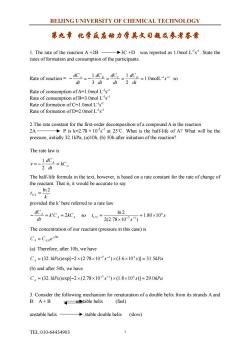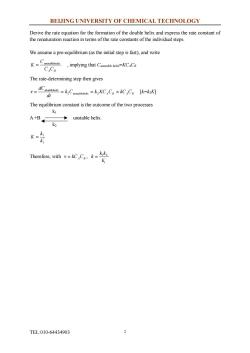北京化工大学:《物理化学》课程教学资源(双语练习题)第九章 化学反应动力学英文习题及参考答案 kinetics problems

BEIJING UNIVERSITY OF CHEMICAL TECHNOLOGY 第九章化学反履的力学美文司题及参考答案 1.The rate of the reaction A+2B 3C+D was reported as 1.0mol Ls State the rates of formation and consumption of the participants Rate of reaction=- -1dCs=dCc=1dCp Rate of consumption ofA=1.0mol Rate of consumption of B=3.0mol Ls Rate of formation of C=1.0mol Ls Rate of formation of D=2.0mol Ls 2.The rate constant for the firs rder dec 2A und A in the reaction Pisk=2.7at 25C.What is the half-life of A?What will be the pressure,initially 32.1kPa,(a)10h,(b)50h after initiation of the reaction? The rate law is The half-life formula in the text,however,is based on a rate constant for the rate of change of the reactant.That is,it would be accurate to say a-2 provided the k'here referred to a rate law -G=kC,=2c,0n=327820可180x10: d The concentration of our reactant(pressure in this case)is C=CA0e2 (a)Therefore,after 10h,we have C4=(32.1kPa)exp-2×(2.78×10-s-)×(3.6×10-s月=31.5kPa (b)and after 50h,we have C4=(32.1kPa)exp[-2×(2.78×10-7s-)×1.8x104s】=29.0kPa 3.Consider the following mechanism for renaturation of a double helix from its strands A and B:A+B ttable helix (fast) unstable helix- stable double helix (slow) TEL:010-64434903 1
BEIJING UNIVERSITY OF CHEMICAL TECHNOLOGY TEL:010-64434903 1 第九章 化学反应动力学英文习题及参考答案 1. The rate of the reaction A +2B 3C +D was reported as 1.0mol L-1 s -1 . State the rates of formation and consumption of the participants. Rate of reaction = 1 1 1.0molL 2 1 3 1 - - - = - = = = s dt dC dt dC dt dC dt dCA B C D so Rate of consumption of A=1.0mol L-1 s -1 Rate of consumption of B=3.0mol L-1 s -1 Rate of formation of C=1.0mol L-1 s -1 Rate of formation of D=2.0mol L-1 s -1 2.The rate constant for the first-order decomposition of a compound A in the reaction 2A P is k=2.78×10-7s -1 at 25℃. What is the half-life of A? What will be the pressure, initially 32.1kPa, (a)10h, (b) 50h after initiation of the reaction? The rate law is A A kC dt dC v = - = 2 1 The half-life formula in the text, however, is based on a rate constant for the rate of change of the reactant. That is, it would be accurate to say 2 ' 1/ ln 2 k t = provided the k’ here referred to a rate law A A A k C kC dt dC - = ' = 2 so s s t 6 1/ 2 7 1 1.80 10 2(2.78 10 ) ln 2 = ´ ´ = - - The concentration of our reactant (pressure in this case) is kt A A C C e 2 ,0 - = (a) Therefore, after 10h, we have C kPa s s kPa A (32.1 )exp[ 2 (2.78 10 ) (3.6 10 )] 31.5 7 1 4 = - ´ ´ ´ ´ = - - (b) and after 50h, we have C kPa s s kPa A (32.1 )exp[ 2 (2.78 10 ) (1.8 10 )] 29.0 7 1 4 = - ´ ´ ´ ´ = - - 3. Consider the following mechanism for renaturation of a double helix from its strands A and B: A + B unstable helix (fast) unstable helix stable double helix (slow)

BEIJING UNIVERSITY OF CHEMICAL TECHNOLOGY Derive the rate equation for the formation of the double helix and express the rate constant of the renaturation reaction in terms of the rate constants of the individual steps. We assume a pre-equilibrium(as the initial step is fast),and write ,implying that hel=KCACg C.CR The rate-determining step then gives v=C=kC=kKC,C=kC,C。k=k灯 d The equilibrium constant is the outcome of the two processes k A+B unstable helix. k Therere.wh C..-答 TEL:010-64434903
BEIJING UNIVERSITY OF CHEMICAL TECHNOLOGY TEL:010-64434903 2 Derive the rate equation for the formation of the double helix and express the rate constant of the renaturation reaction in terms of the rate constants of the individual steps. We assume a pre-equilibrium (as the initial step is fast), and write A B unstablehelix C C C K = , implying that Cunstable helix=KCACB The rate-determining step then gives unstablehelix A B A B doublehelix k C k KC C kC C dt dC v = = 2 = 2 = [k=k2K] The equilibrium constant is the outcome of the two processes k1 A +B unstable helix. k2 ' 1 1 k k K = Therefore, with ACB v = kC , ' 1 1 2 k k k k =
按次数下载不扣除下载券;
注册用户24小时内重复下载只扣除一次;
顺序:VIP每日次数-->可用次数-->下载券;
- 北京化工大学:《物理化学》课程教学资源(双语练习题)第七章 电化学英文习题及参考答案 electrochemistry problems.pdf
- 北京化工大学:《物理化学》课程教学资源(双语练习题)第三章 热力学第二定律英文习题及参考答案 secondlaw problems.pdf
- 北京化工大学:《物理化学》课程教学资源(双语练习题)第四章 多组分系统热力学英文习题及参考答案 mixture problems.pdf
- 北京化工大学:《物理化学》课程教学资源(双语练习题)第二章 热力学第一定律英文习题及参考答案 firstlaw problems.pdf
- 北京化工大学:《物理化学》课程教学资源(双语练习题)第一章 气体英文习题及参考答案 gas problems.pdf
- 北京化工大学:《物理化学》课程教学资源(双语习题课)Phase equilibrium.pdf
- 北京化工大学:《物理化学》课程教学资源(双语习题课)The Second Law of Thermodynamics.pdf
- 北京化工大学:《物理化学》课程教学资源(双语习题课)The thermodynamics of mixtures.pdf
- 北京化工大学:《物理化学》课程教学资源(双语习题课)Chemical equilibrium.pdf
- 北京化工大学:《物理化学》课程教学资源(双语习题课)The First Law of Thermodynamics.pdf
- 北京化工大学:《物理化学》课程教学资源(大纲教案)双语教学大纲 Physical Chemistry.pdf
- 北京化工大学:《物理化学》课程教学资源(大纲教案)物理化学双语班《物理化学》教学大纲.pdf
- 北京化工大学:《物理化学》课程教学资源(大纲教案)理科实验班《物理化学》教学大纲.pdf
- 北京化工大学:《物理化学》课程教学资源(大纲教案)工科非化工类卓越工程师实验班《物理化学》教学大纲.pdf
- 北京化工大学:《物理化学》课程教学资源(大纲教案)工科化工类专业《物理化学》教学大纲.pdf
- 北京化工大学:《物理化学》课程教学资源(大纲教案)理科应用化学专业《物理化学》教学大纲.pdf
- 长沙理工大学:《分析化学》课程教学资源(课件讲稿)第六章 氧化还原滴定法.pdf
- 长沙理工大学:《分析化学》课程教学资源(课件讲稿)第七章 重量分析法和沉淀滴定法.pdf
- 长沙理工大学:《分析化学》课程教学资源(课件讲稿)第五章 配位滴定法.pdf
- 长沙理工大学:《分析化学》课程教学资源(课件讲稿)第四章 酸碱滴定法.pdf
- 北京化工大学:《物理化学》课程教学资源(双语练习题)第八章 统计热力学初步英文习题及参考答案 staticcalthermodynamics problems.pdf
- 北京化工大学:《物理化学》课程教学资源(双语练习题)第十章 表面化学英文习题及参考答案 surfaceandcolloid problems.pdf
- 北京化工大学:《物理化学》课程教学资源(双语实践教学)electrochemical determination of GHS.pdf
- 北京化工大学:《物理化学》课程教学资源(双语实践教学)kinetics the iodine clock reaction.pdf
- 北京化工大学:《物理化学》课程教学资源(双语模拟试题)test four.pdf
- 北京化工大学:《物理化学》课程教学资源(双语模拟试题)test one.pdf
- 北京化工大学:《物理化学》课程教学资源(双语模拟试题)test three.pdf
- 北京化工大学:《物理化学》课程教学资源(双语模拟试题)test two.pdf
- 北京化工大学:《物理化学》课程教学资源(双语读书报告)air polution control.pdf
- 北京化工大学:《物理化学》课程教学资源(双语读书报告)Biosurfactants.pdf
- 北京化工大学:《物理化学》课程教学资源(双语读书报告)Explosion of battery.pdf
- 北京化工大学:《物理化学》课程教学资源(双语读书报告)Rain Making.pdf
- 北京化工大学:《物理化学》课程教学资源(双语读书报告)Lithium Battery.pdf
- 北京化工大学:《物理化学》课程教学资源(双语读书报告)lithium ion battery.pdf
- 北京化工大学:《物理化学》课程教学资源(双语读书报告)Nano lantern.pdf
- 北京化工大学:《物理化学》课程教学资源(双语读书报告)nanotechnology.pdf
- 北京化工大学:《物理化学》课程教学资源(双语读书报告)Surface Tension.pdf
- 北京化工大学:《物理化学》课程教学资源(双语读书报告)surfactant in cosmetic.pdf
- 北京化工大学:《物理化学》课程教学资源(双语读书报告)What is Colloid.pdf
- 《物理化学》课程教学资源(数值计算)01 范德华气体(Van der Waals状态方程式).pdf
